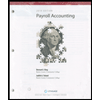
a.
Explain the purpose of debt service funds.
a.
Explanation of Solution
GAAP illustrates the purpose of debt service funds as to account for and report the financial resources which are restricted, committed or assigned to expenditure for principal or interest on long term liabilities. Only the general government long term liabilities those which are repaid by the governmental fund resources are serviced through debt service funds.
b.
Explain the situation that GAAP requires for the use of a debt service fund.
b.
Explanation of Solution
GAAP needs that a debt service funds as to be used to account for debt service on general long-term liabilities if the following conditions are true.
- Debt service fund use is legally or contractually mandated or,
- For the usage in future resources are being currently accumulated.
c.
Explain the reason for use of debt service fund by government even if it is not required to do so.
c.
Explanation of Solution
Use of debt service fund related to general long-term liabilities and are generally not prohibited. A government usually want to use a debt service fund for a serial bond issue even when there is no requirement for doing so and in order to better manage and control its debt service accounting for all debt service in debt service funds. In this point of view, all general government debt service will be accounted and financed through debt service funds, not some through special revenue funds or general funds and some through debt service funds. Also in the process of transferring resources from the general fund or special revenue funds to debt service funds will avoid the possibility of resources required for debt service being used for the other needs. Finally, many task including reconciling accounts with fiscal agent to auditing debt service transactions are being facilitated by accounting for all general government debt service in debt service funds.
Want to see more full solutions like this?
Chapter 8 Solutions
Governmental and Nonprofit Accounting (11th Edition)
- what will the pretax income equal if sales are..... ?arrow_forwardI am looking for the correct answer to this general accounting question with appropriate explanations.arrow_forwardOn May 1st, Golden Harvest, Inc. purchased $1,500 worth of supplies on account. On December 31st, the fiscal year-end for Golden Harvest, it is determined that $800 worth of supplies still remain. What is the balance in the supplies account after adjustment?arrow_forward
- Can you explain the process for solving this General accounting question accurately?arrow_forwardI need help finding the accurate solution to this general accounting problem with valid methods.arrow_forwardMathur Manufacturing uses a job order costing system. During one month, Mathur purchased $188,000 of raw materials on credit; issued materials to the production of $263,000 of which $17,000 were indirect. Mathur incurred a factory payroll of $172,000, of which $25,000 was indirect labor. Mathur uses a predetermined overhead rate of 150% of direct labor cost. The total manufacturing costs added during the period are_.arrow_forward
- I need help solving this general accounting question with the proper methodology.arrow_forwardI am looking for help with this general accounting question using proper accounting standards.arrow_forwardDuring FY 2005 Plastic Manufacturing had total manufacturing costs are $418,000. Their cost of goods manufactured for the year was $448,000. The January 1, 2006 balance of the Work-in-Process Inventory is $49,000. Use this information to determine the dollar amount of the FY 2005 beginning Work-in-Process Inventory.arrow_forward
 Intermediate Accounting: Reporting And AnalysisAccountingISBN:9781337788281Author:James M. Wahlen, Jefferson P. Jones, Donald PagachPublisher:Cengage Learning
Intermediate Accounting: Reporting And AnalysisAccountingISBN:9781337788281Author:James M. Wahlen, Jefferson P. Jones, Donald PagachPublisher:Cengage Learning Century 21 Accounting Multicolumn JournalAccountingISBN:9781337679503Author:GilbertsonPublisher:Cengage
Century 21 Accounting Multicolumn JournalAccountingISBN:9781337679503Author:GilbertsonPublisher:Cengage





